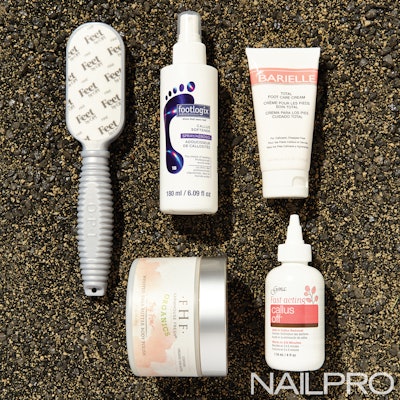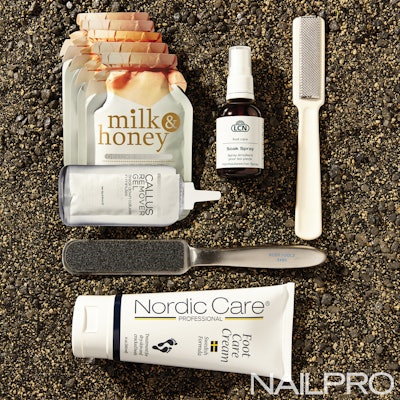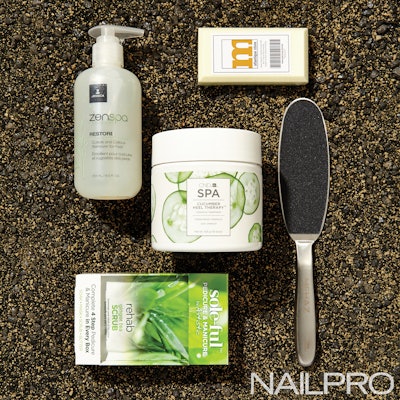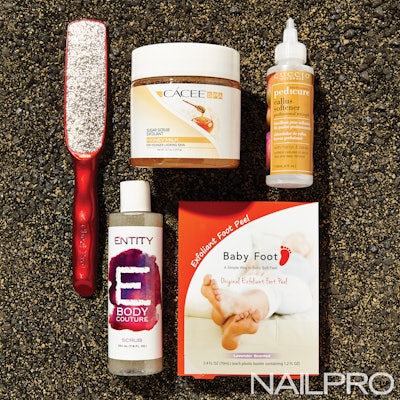As a nail professional, you’ve seen your fair share of calluses in the salon. Formed when skin accumulates over areas of continual pressure, friction or irritation, they can be unsightly and uncomfortable. While many clients hope to leave their pedicure appointment callus-free, that’s rarely, if ever, the best course of action. “A callus is there for a reason,” explains Vicki Malo, president of the North American School of Podology in Toronto, Canada. “They are the body’s natural protective mechanism.” So, how do you please your client and properly care for her calluses?
Here, eight do’s and don’ts, plus our top picks for products designed to smooth rough skin.

1. DO know your state board regulations. Many boards define the complete removal of a callus as a medical procedure and strictly prohibit the use of razors, rasps or other types of shavers during a service. (In fact, in some states it’s even illegal to have a callus blade on the salon premises!) There are several states that don’t define callus treatment provisions; however, techs should always refrain from performing invasive procedures on living tissue.
2. DON’T use tools that are difficult to clean and disinfect. Filing down a callus leaves behind a lot of dead tissue in tools and implements. Sanitation is critical for every service, of course, but pedicure services are especially scrutinized. Choose high quality tools that can be adequately scrubbed after use. Foot files with replaceable, single-use abrasives are also a good option.
3. DO start with a thorough consultation. Before performing any type of foot service on a client, ask about existing medical conditions, age and lifestyle as they can all impact callus treatment. “As we mature, the skin on the bottom of the feet becomes thinner,” says Malo. “In some cases, a callus is the only protection against the trauma of walking.” This is especially important when treating diabetics, where a small break in the skin can evolve into a life-threatening infection.

4. DON’T use caustic callus softeners on diabetics and seniors. These products contain ingredients such as salicylic acid and potassium hydroxide which can cause chemical burns on extremely fragile skin. Greasy, heavy salves should also be avoided. “These products don’t readily absorb into the skin and may only give a superficial effect,” says Malo.

5. DO soak the feet prior to treating a callus. Five to 10 minutes in warm water is usually sufficient. As the dead skin cells of the stratum corneum, or outermost layer of skin, soak up water, they swell and soften. Dry the feet before applying a callus softener and allow it to penetrate for two to three minutes before gently filing the callused area, says Malo.
6. DON’T soften too much. Malo recommends softening no more than 2/3 of a callus. For clients with certain risk factors, such as diabetes, or lifestyle activities, including long distance running, softening just 1/3 to 1/2 of the callus may be more appropriate. If you file too much, the client may experience discomfort and could develop ulcerations.

7. DO recommend home care. Client upkeep can keep calluses soft between pedicure appointments. Malo suggests daily use of a moisturizing product formulated for the feet, proper footwear or even a trip to a podiatrist for assessment of orthotics.
8. DON’T treat a callus that is soft, spongy or reddish-brown in color. This could indicate a medical problem, such as a callus that has built up over an ulcer or blood blister. Says Malo, “If you have any doubts at all, refer the client to a podiatrist or medical professional.”

What’s your favorite technique for taking care of calluses? Let us know in the comments below!
[Images: Photography by Armando Sanchez]
This article was first published in the April 2017 issue of NAILPRO











